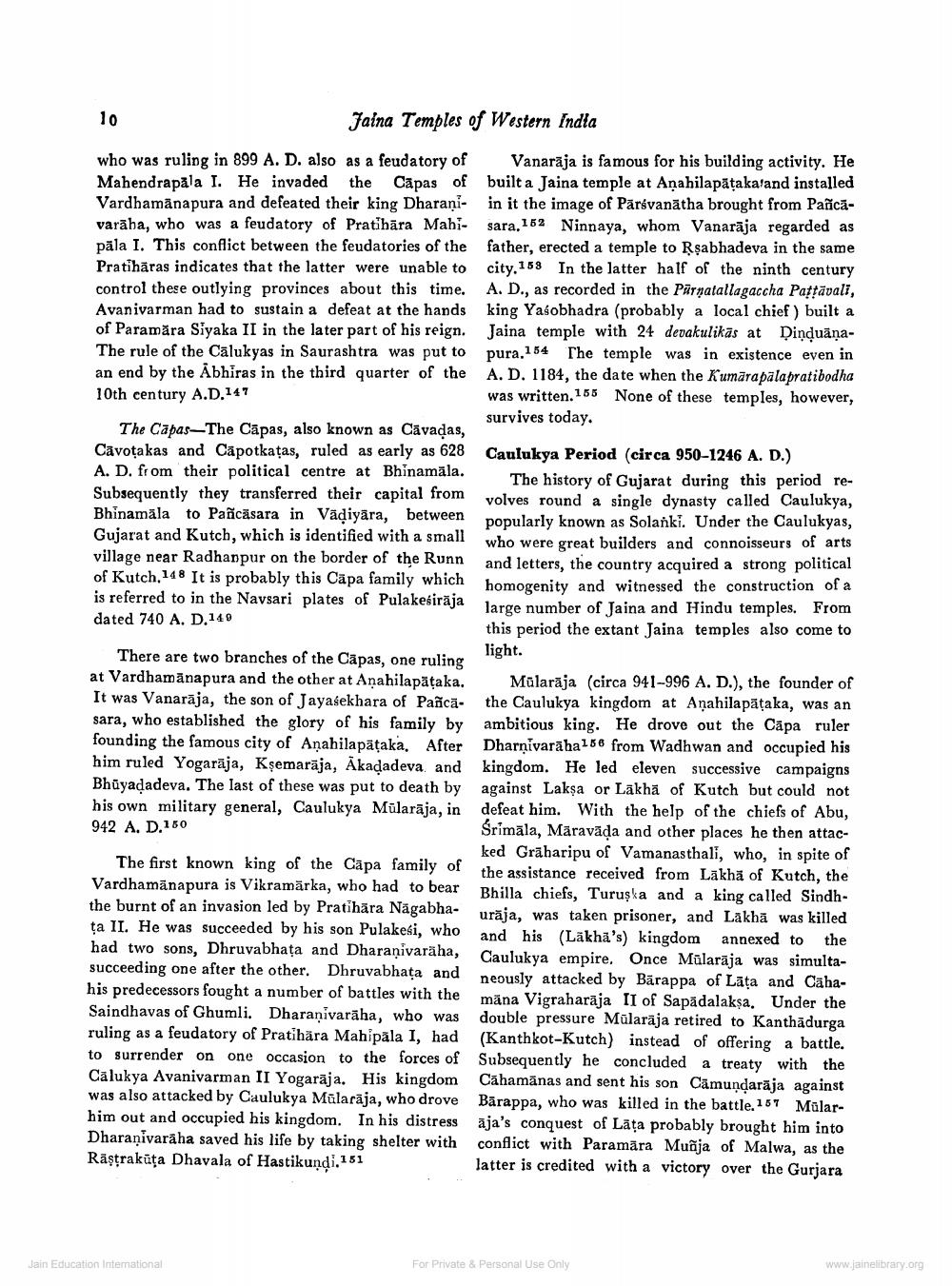________________
10
Jaina Temples of Western Indła
who was ruling in 899 A. D. also as a feudatory of Vanarāja is famous for his building activity. He Mahendrapala I. He invaded the Capas of built a Jaina temple at Anahilapātaka and installed Vardhamanapura and defeated their king Dharani- in it the image of Pārsvanātha brought from Pañcavarāha, who was a feudatory of Pratihāra Mahi- sara. 152 Ninnaya, whom Vanarāja regarded as pāla I. This conflict between the feudatories of the father, erected a temple to Rşabhadeva in the same Pratihāras indicates that the latter were unable to city. 158 In the latter half of the ninth century control these outlying provinces about this time. A. D., as recorded in the Pärnatallagaccha Patļāvali, Avanivarman had to sustain a defeat at the hands king Yaśobhadra (probably a local chief ) built a of Paramăra Siyaka II in the later part of his reign. Jaina temple with 24 devakulikās at DinduāņaThe rule of the Calukyas in Saurashtra was put to pura.154 The temple was in existence even in an end by the Abhiras in the third quarter of the A.D. 1184, the date when the Kumārapālapratibodha 10th century A.D.147
was written.155 None of these temples, however,
survives today. The Capas—The Capas, also known as Cāvaļas, Cavotakas and Cäpotkațas, ruled as early as 628 Caulukya Period (circa 950-1246 A. D.) A. D. from their political centre at Bhinamäla.
The history of Gujarat during this period reSubsequently they transferred their capital from volves round a single dynasty called Caulukya, Bhinamāla to Pañcāsara in Vädiyāra, between
popularly known as Solanki. Under the Caulukyas, Gujarat and Kutch, which is identified with a small
who were great builders and connoisseurs of arts village near Radhanpur on the border of the Runn and letters, the country acquired a strong political of Kutch.148 It is probably this Cäpa family which
homogenity and witnessed the construction of a is referred to in the Navsari plates of Pulakesirāja
large number of Jaina and Hindu temples. From dated 740 A. D.149
this period the extant Jaina temples also come to There are two branches of the Capas, one ruling
light. at Vardhamānapura and the other at Anahilapāțaka. Mūlarāja (circa 941-996 A. D.), the founder of It was Vanarāja, the son of Jayasekhara of Pañcā- the Caulukya kingdom at Anahilapāțaka, was an sara, who established the glory of his family by ambitious king. He drove out the Căpa ruler founding the famous city of Anahilapāțaka. After Dharnivarāha166 from Wadhwan and occupied his him ruled Yogarāja, Ksemarāja, Akadadeva, and kingdom. He led eleven successive campaigns Bhūyadadeva. The last of these was put to death by against Lakṣa or Lākhā of Kutch but could not his own military general, Caulukya Mūlarāja, in defeat him. With the help of the chiefs of Abu, 942 A. D.160
Srimala, Māravāda and other places he then attac
ked Graharipu of Vamanasthali, who, in spite of The first known king of the Capa family of the assistance received from Lakha of Kutch, the Vardhamānapura is Vikramārka, who had to bear
Bhilla chiefs, Turuşka and a king called Sindhthe burnt of an invasion led by Pratihāra Nagabha
urāja, was taken prisoner, and Lakbā was killed ta II. He was succeeded by his son Pulakesi, who and his (Lakha's) kingdom annexed to the had two sons, Dhruvabhata and Dharanivaräha,
Caulukya empire. Once Mūlarāja was simultasucceeding one after the other. Dhruvabhata and
neously attacked by Bārappa of Lāta and Cahahis predecessors fought a number of battles with the mäna Vigraharāja II of Sapädalaksa. Under the Saindhavas of Ghumli. Dharanivarāha, who was double pressure Mularāja retired to Kanthadurga ruling as a feudatory of Pratihära Mahipala I, had (Kanthkot-Kutch) instead of offering a battle. to surrender on one occasion to the forces of Subsequently he concluded a treaty with the Calukya Avanivarman II Yogaraja. His kingdom Cāhamānas and sent his son Camundarāja against was also attacked by Caulukya Mülarāja, who drove Bārappa, who was killed in the battle.167 Mülarhim out and occupied his kingdom. In his distress aja's conquest of Lāta probably brought him into Dharanivaräha saved his life by taking shelter with conflict with Paramāra Muõja of Malwa, as the Rāştrakūta Dhavala of Hastikundi.151
latter is credited with a victory over the Gurjara
Jain Education International
For Private & Personal Use Only
www.ainelibrary.org




